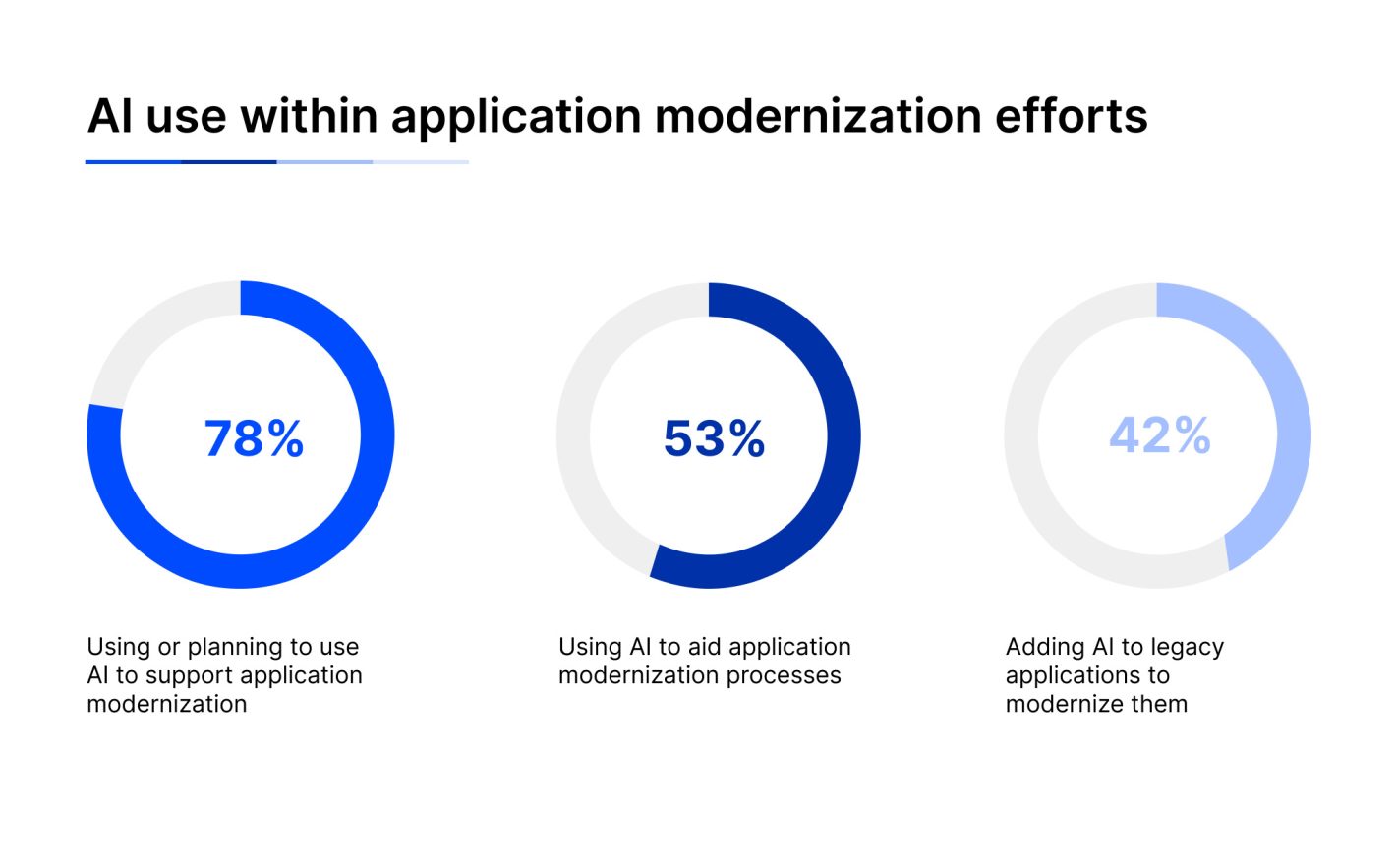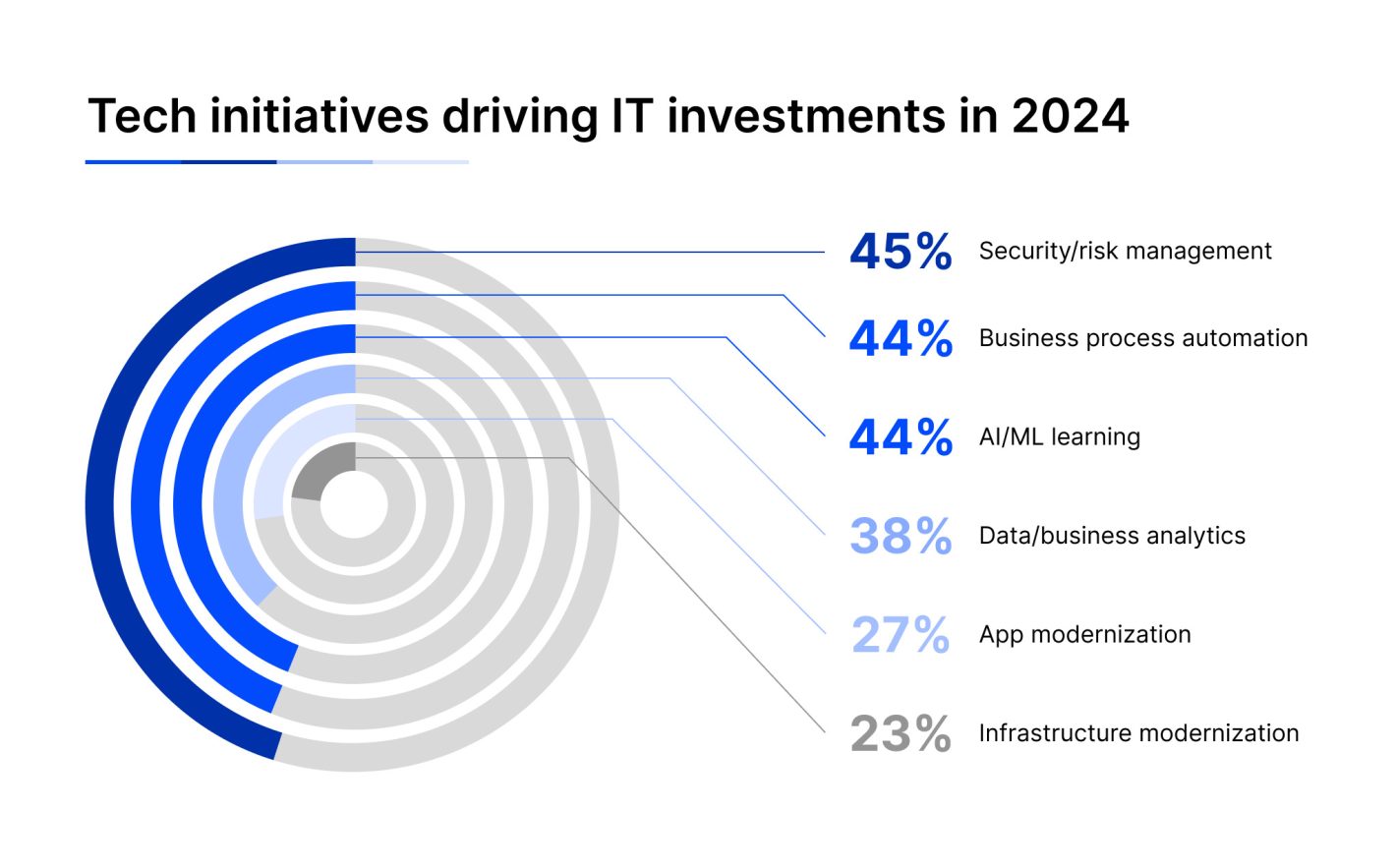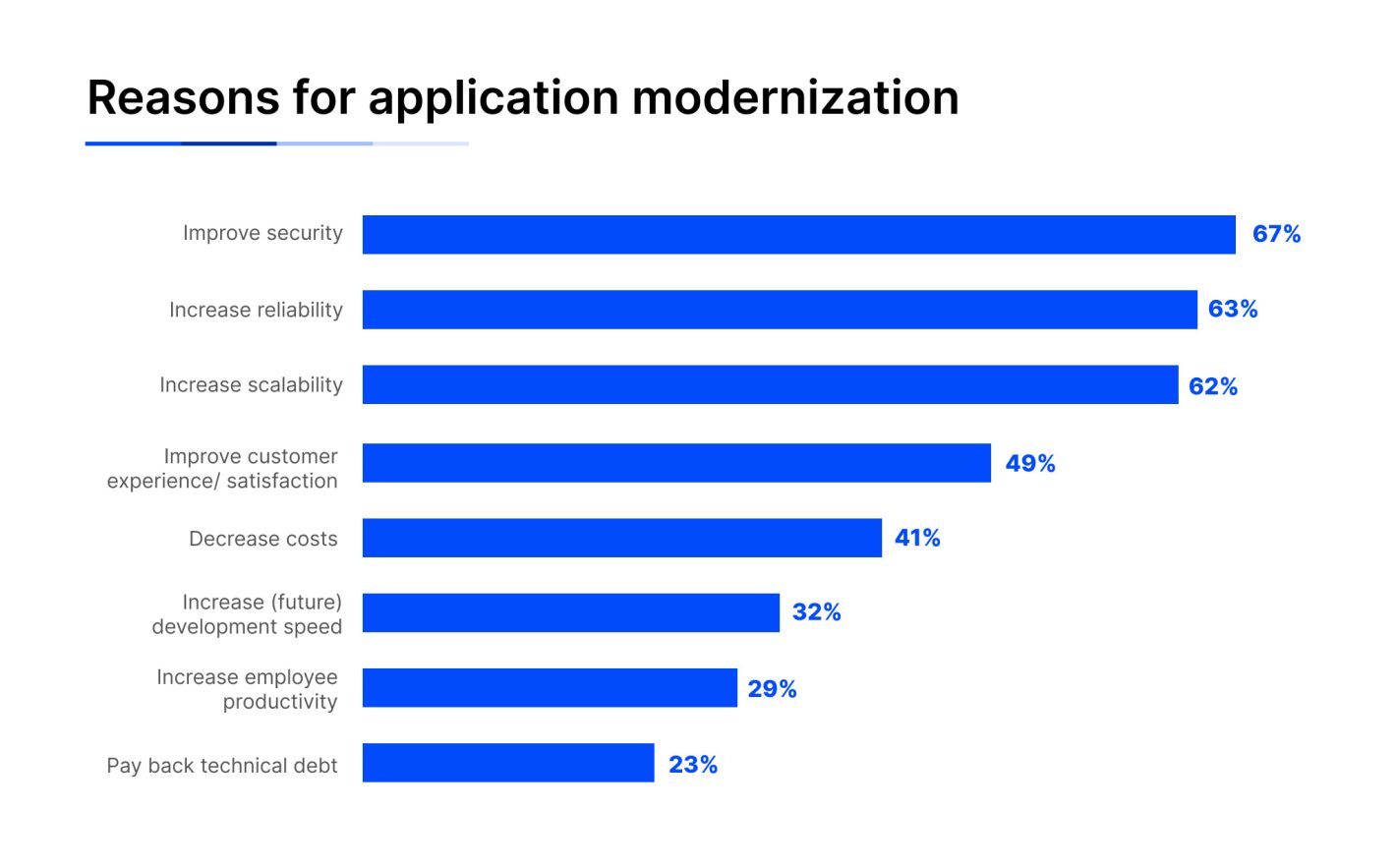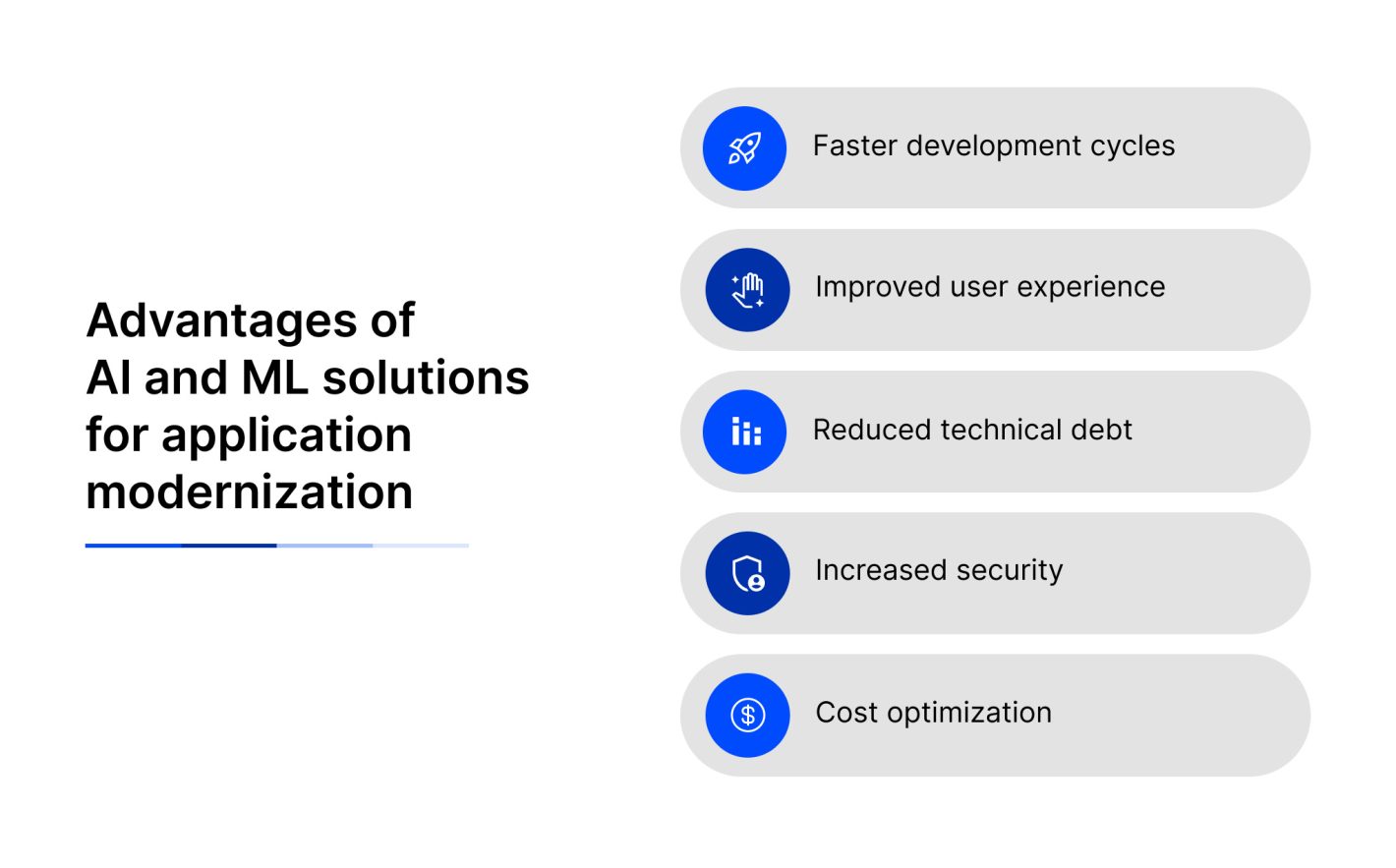Application modernization has taken center stage in recent years. In 2022, a vFunction survey reported that 92% of respondents planned to or have already started their app modernization projects. 2024 is no different: organizations are shifting their budgets from delivering new infrastructure, cloud services, and modern applications to modernizing legacy and business applications as their top priority.
Moreover, 78% of organizations use or plan to use artificial intelligence (AI) to support their application modernization efforts.

Source: The state of application modernization, RedHat
In this blog article, together with Sombra’s Head of Engineering, Mykhaylo Voitovych, we’re exploring whether there are any AI and ML solutions that can tackle real-world business problems of monolithic applications and whether it’s worth investing heavily into them to solve all your app modernization challenges.
What are the common problems businesses encounter with legacy apps?
Several years into the post-pandemic period, IT organizations are still consumed by efforts to optimize and transform operations. Yet there’s a growing undercurrent of capitalizing on emerging technologies like AI to reimagine the business in new and compelling ways.

Source: State of the CIO Survey 2024, Foundry
What do we hear from our clients?
So, what exactly motivates IT leaders to invest more in application modernization? Here are the challenges our clients say they face maintaining legacy applications.
- Time-consuming feature implementation and bug fixing
Traditional processes hinder rapid iteration and bug resolution. The root causes usually include absence of people who developed the system in the first place, old architectural patterns, coding practices and technologies, multiple patches added one on top of another during years of usage / extension without proper documentation. - Long time-to-market for applications
Delays in launching apps and updates slow down business growth. - Legacy systems and technical debt
Old technologies create barriers to innovation and increase maintenance costs. - Poor user experience
Unresponsive, outdated interfaces negatively impact customer satisfaction. - Performance issues
Slow, inefficient apps drive away users and increase churn. - Security vulnerabilities
Outdated security measures leave systems exposed to attacks. - High infrastructure costs
Legacy systems are expensive to maintain and scale.
Indeed, the findings of RedHat’s recent report on the state of application modernization support our claims.

Source: The state of application modernization, RedHat
The real value of maintaining outdated technology
Sitting on an aging technology is like a ticking time bomb that might go off at any moment. The aftermath might disrupt your business, create a need for unprecedented spending, and even result in a lawsuit. Here are a few examples of events happening to some of the world’s most famous businesses.
Delta Air Lines
Delta Air Lines, one of the four big players in the U.S. airline industry, lost $150 million in income due to an outdated reservation system developed in the 1960s. However, the company was using it in 2016 when the system crashed massively.
Over 2000 flights were canceled due to this incident, and many customers expressed distrust in the company and reluctance to use its services in the future.
Therefore, it is better to switch to the new technologies regardless of how stable the processes are in the current system. Gradually adopt new technologies for smooth workflow transition.
Hershey
Hershey Foods, Inc., one of the largest chocolate manufacturers in the world, used an outdated ERP developed in 1999. When the company authorities realized the system no longer met modern requirements, they were desperate to update it as quickly as possible.
Despite the recommended 48 months for new system implementation, Hershey pushed deadlines and launched the updated system within 30 months.
The company also updated ERP, supply chain, and CRM components that weren’t properly tested. During the peak season of Halloween sales, Hershey’s sales were down 12%, to $1.06 billion from $1.2 billion. Eventually, they lost market share and reported a 19% Net Income drop in third-quarter earnings.
Thus, forcing the launch of an untested system isn’t a good idea. Create a detailed plan for migrating your legacy tech, hire expert developers, and set realistic deadlines.
On the contrary, a timely application modernization not only addresses current business problems but also creates new growth opportunities.
Lyft
Lyft is the second-largest ridesharing company in the United States. Soon after its success, the company needed to scale its services across several cities in the US and Canada, which required rebuilding the infrastructure to facilitate efficient scaling. Lyft’s legacy infrastructure outgrew its capacity.
The Lyft engineering team migrated to Kubernetes and created a hybrid environment for communication with legacy services. Thus, Lyft’s application modernization and migration to Kubernetes reduced the tech debt of tightly coupled architecture. It also helped Lyft achieve better visibility for engineers. Using Flyte and Envoy, Lyft has deployed the following:
- 600 microservices running on 300,000 containers on a single Envoy mesh
- A ride-sharing cluster made of 30,000 pods that scale automatically
- Fault-tolerant EnvoyManager to operate and optimize the system’s multi-cluster environment
Spotify
In its early days, Spotify released a web player and a desktop app to offer music streaming services worldwide. However, Spotify struggled to deliver new features rapidly because the tech stacks of each format were so different, and context switching was complex. Additionally, the team faced accessibility issues in the web player and the desktop app.
Ultimately, Spotify’s engineering team decided to modernize its web player so it matches the feature richness and performance of the desktop app. Re-architecting the UI allowed Spotify to offer a consistent multi-channel experience to its users.
Re-architecture the frontend infrastructure to an API-based design pattern, they achieved the following:
- Increased velocity for the development teams
- Added features to the web player like downloading, offline mode, local files, lyrics, a “Now Playing” queue, sorting and filtering of playlists and albums
- Complete launch of the new desktop client with advanced features within a year
AI and ML solutions for problems in app modernization
As we’ve already learned, legacy applications, built years or even decades ago, can be costly to maintain, challenging to scale, and vulnerable to security risks. They cause real trouble if not upgraded promptly.
Modern technologies, like GenAI, AI and ML, offer powerful tools for solving some of the challenges in legacy system upgrade. Here’s four solutions we at Sombra work with to accelerate modernization of your application:

Common business problems of legacy applications
AI-powered generation via LLMs
Solution overview: Large Language Models (LLMs) can generate code, automated tests, CI/CD scripts, infrastructure-as-code, and documentation. This comprehensive automation speeds up feature implementation, bug fixing, and deployment processes, which directly reduces time-to-market and improves overall code quality.
Problems addressed:
- Long Time-to-Market for Apps
- Time-Consuming Feature Implementation and Bug Fixing
Toolset:
- GitHub Copilot: Code generation and documentation assistance.
- OpenAI Codex: General-purpose coding and infrastructure automation.
AI-assisted debugging and code quality analysis
Solution overview: AI tools streamline debugging by automatically identifying potential bugs, code inefficiencies, and security vulnerabilities. They also analyze code quality for maintainability and modifiability, which reduces technical debt over time.
Problems addressed:
- Time-Consuming Feature Implementation and Bug Fixing
- Addressing Security Vulnerabilities
Toolset:
- DeepCode: AI-driven bug detection and code quality analysis.
- SonarQube: Code quality, security analysis and AI-generated fix suggestions (in newer versions)
Automated code refactoring and legacy system assessment
Solution overview: AI tools refactor outdated code and assess legacy systems to reduce technical debt, improve performance, and make code more maintainable.
Problems addressed:
- Legacy systems and technical debt
- High infrastructure costs
Toolset:
- Swimm: AI tool for refactoring legacy codebases
- GitHub Copilot: Code generation and documentation assistance.
AI chatbots and virtual assistants
Solution overview: AI chatbots and virtual assistants improve user experience by providing real-time support and handling complex queries, reducing workload on support staff.
Problems addressed:
- Poor user experience
Toolset:
LivePerson: AI-powered virtual assistant and chatbot for customer support.
Ada: Automated chatbot with natural language processing for insurance and financial service providers
Advantages of AI and ML solutions usage for application modernization
Companies have spent the past year exploring new AI capabilities. Now, when the focus is shifting to scalability and ROI, those solutions deliver real and sustainable value for the business, including:

Advantages of AI/ML solutions for application modernization
AI and ML solutions: use cases
We’re already seeing how leading companies across various industries are using AI within their SAP environments. They are leveraging AI to target poor user experience:
JPMorgan Chase & Co
JPMorgan has invested heavily in AI-based technologies for various applications, such as customer service. The company uses AI to modernize legacy systems and improve operational efficiency in its business lines.
Citigroup
Citigroup started integrating AI into its daily operations in 2019, leveraging AI algorithms for customer compliance service to identify weaknesses and bottlenecks. In the long term, this led to improved customer service, higher satisfaction rates, and the ability to provide customers with personalized experiences.
HSBC
HSBC adopts contextual LLM to describe users’ data, increasing user experience and satisfaction
When should AI not be used in app modernization?
AI is a powerful tool and might seriously boost one’s application modernization efforts. However, it’s not a one-size-fits-all solution. As an application modernization company, we have started working with our clients’ legacy modernization requests from assessment. Therefore, we analyze and review the software for specific business problems and provide the client with actionable recommendations.
For example, here’s how we worked with upgrading one of our client’s 20-year-old ERP system, helping them go paperless to save costs.
We’d advise the client whether AI is a necessary adoption for software modernization or just a waste of time and effort.
Here are the three cases we advise against AI solutions:
When modernization goals can be achieved with simpler solutions:
If traditional methods, such as manual refactoring or rule-based automation, can easily handle the modernization tasks, using AI tools may overcomplicate the process. Simple code migrations and system upgrades may not require the complexity and overhead of AI-based solutions.
When there is insufficient data for effective AI tool use:
AI-based modernization tools often rely on data for code analysis, optimization suggestions, or automated testing. If there isn’t enough historical codebase or performance data, the AI tools may not provide meaningful insights or improvements, making traditional methods a better option.
When cost and time investment in AI tools outweigh benefits:
AI-based modernization tools typically involve significant implementation costs and usually require skilled professionals to manage them. If the modernization project is small in scope or if traditional methods can achieve results more quickly, the expenses and time required to set up AI tools may not be justified.
If you’re looking for an experienced vendor who not only carries out a job but also acts in your best interests – contact us.
Conclusion
Let’s sum up: businesses will inevitably modernize their legacy applications. The vFunction survey revealed that 92% of respondents are planning to or have already begun their app modernization projects. This is particularly true as many are encountering:
- Long time-to-market for applications
- Time-consuming feature implementation and bug fixing
- Legacy systems and technical debt
- Poor user experience
- Performance issues
- Security vulnerabilities
- High infrastructure costs
AI’s just reached the peak of its popularity and will be expensively pushed to be used to accelerate application modernization efforts. The solutions offered by AI/ML technologies can indeed be beneficial, as they can:
- Fasten development cycles
- Improve user experience
- Reduce technical debt
- Increase security
- Optimize costs
The four solutions we’re talking about include:
- AI-powered generation via LLMs
- AI-assisted debugging and code quality analysis
- Automated code refactoring and legacy system assessment
- AI chatbots and virtual assistants
While we at Sombra believe AI brings a lot of value to the software modernization process, it can also become a burden when modernization goals can be achieved with simpler solutions, when there is insufficient data for effective AI tool usage, or when the cost and time invested in AI adoption outweigh the benefits.
Therefore, to avoid having your outdated software damage your business at any moment, as happened to Delta Airlines or Hershey, add application modernization to your business strategy and hire expert developers to help you with that process. At Sombra, we offer multiple application modernization solutions based on your challenges, including
- Cloud infrastructure migration
- Security improvement
- UI/UX design enhancement
- Agile development and DevSecOps
- Legacy system modernization and technical debt reduction
- Performance optimization
Contact us to explore how we can help your business grow ahead of competitors.











